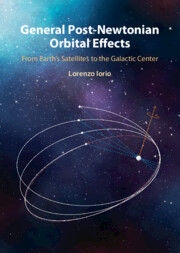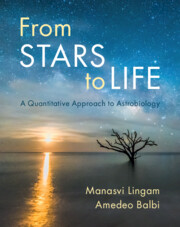Refine listing
Actions for selected content:
17002 results
11 - ‘Exotic’ Life
- from Part IV - Astrobiological Targets
-
- Book:
- From Stars to Life
- Published online:
- 22 November 2024
- Print publication:
- 05 December 2024, pp 246-265
-
- Chapter
- Export citation
5 - 1pN Gravitomagnetic Effects: Spin Dipole(s)
-
- Book:
- General Post-Newtonian Orbital Effects
- Published online:
- 28 November 2024
- Print publication:
- 05 December 2024, pp 84-118
-
- Chapter
- Export citation
Appendix G - Coefficients of the Total Mixed Net Orbital Shifts of the Order of J2/c2
-
- Book:
- General Post-Newtonian Orbital Effects
- Published online:
- 28 November 2024
- Print publication:
- 05 December 2024, pp 203-206
-
- Chapter
- Export citation
Dedication
-
- Book:
- From Stars to Life
- Published online:
- 22 November 2024
- Print publication:
- 05 December 2024, pp v-vi
-
- Chapter
- Export citation
Part V - Detecting Life
-
- Book:
- From Stars to Life
- Published online:
- 22 November 2024
- Print publication:
- 05 December 2024, pp 291-292
-
- Chapter
- Export citation
Appendix K - Post-Keplerian Orbital Effects: Numerical Values
-
- Book:
- General Post-Newtonian Orbital Effects
- Published online:
- 28 November 2024
- Print publication:
- 05 December 2024, pp 217-229
-
- Chapter
- Export citation
Appendix C - pK Disturbing Functions from the Spacetime Metric
-
- Book:
- General Post-Newtonian Orbital Effects
- Published online:
- 28 November 2024
- Print publication:
- 05 December 2024, pp 190-193
-
- Chapter
- Export citation
7 - Newtonian Effects: Mass Quadrupole(s)
-
- Book:
- General Post-Newtonian Orbital Effects
- Published online:
- 28 November 2024
- Print publication:
- 05 December 2024, pp 123-145
-
- Chapter
- Export citation
1 - The Foundations of Astrobiology
- from Part I - Astronomical Origins
-
- Book:
- From Stars to Life
- Published online:
- 22 November 2024
- Print publication:
- 05 December 2024, pp 3-12
-
- Chapter
- Export citation
3 - Planet Formation and Migration
- from Part I - Astronomical Origins
-
- Book:
- From Stars to Life
- Published online:
- 22 November 2024
- Print publication:
- 05 December 2024, pp 37-72
-
- Chapter
- Export citation

General Post-Newtonian Orbital Effects
- From Earth's Satellites to the Galactic Centre
-
- Published online:
- 28 November 2024
- Print publication:
- 05 December 2024

From Stars to Life
- A Quantitative Approach to Astrobiology
-
- Published online:
- 22 November 2024
- Print publication:
- 05 December 2024
6 - Four-dimensional on-shell supergravity and how to count degrees of freedom
- from Part I - Formalism
-
- Book:
- Introduction to Supergravity and its Applications
- Published online:
- 14 November 2024
- Print publication:
- 21 November 2024, pp 69-78
-
- Chapter
- Export citation
18 - Extremal and black p-brane solutions of supergravity; Tseytlin’s harmonic function rule
- from Part II - Applications
-
- Book:
- Introduction to Supergravity and its Applications
- Published online:
- 14 November 2024
- Print publication:
- 21 November 2024, pp 223-239
-
- Chapter
- Export citation
25 - Kappa symmetry and spacetime supergravity equations of motion; superembedding formalism
- from Part II - Applications
-
- Book:
- Introduction to Supergravity and its Applications
- Published online:
- 14 November 2024
- Print publication:
- 21 November 2024, pp 325-340
-
- Chapter
- Export citation
27 - Maldacena–Núñez and supergravity no-go theorems; loopholes
- from Part II - Applications
-
- Book:
- Introduction to Supergravity and its Applications
- Published online:
- 14 November 2024
- Print publication:
- 21 November 2024, pp 353-364
-
- Chapter
- Export citation
3 - Introduction to supersymmetry 1:Wess–Zumino models, on-shell and off-shell supersymmetry
- from Part I - Formalism
-
- Book:
- Introduction to Supergravity and its Applications
- Published online:
- 14 November 2024
- Print publication:
- 21 November 2024, pp 30-42
-
- Chapter
- Export citation
15 - N = 2 sugra in 4 dimensions, general sugra theories, and N = 1 sugra in 11 dimensions
- from Part I - Formalism
-
- Book:
- Introduction to Supergravity and its Applications
- Published online:
- 14 November 2024
- Print publication:
- 21 November 2024, pp 162-174
-
- Chapter
- Export citation
Index
-
- Book:
- Introduction to Supergravity and its Applications
- Published online:
- 14 November 2024
- Print publication:
- 21 November 2024, pp 421-426
-
- Chapter
- Export citation
13 - Kaluza–Klein (KK)-dimensional reduction and examples
- from Part I - Formalism
-
- Book:
- Introduction to Supergravity and its Applications
- Published online:
- 14 November 2024
- Print publication:
- 21 November 2024, pp 137-147
-
- Chapter
- Export citation
